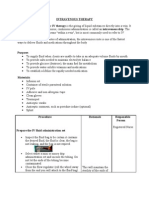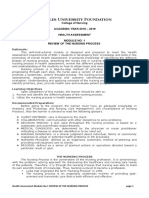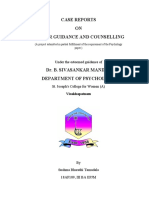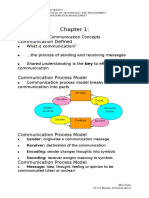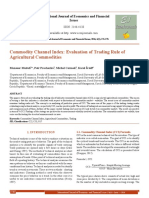Nursing Process
Nursing Process
Uploaded by
Josal SinonCopyright:
Available Formats
Nursing Process
Nursing Process
Uploaded by
Josal SinonOriginal Description:
Copyright
Available Formats
Share this document
Did you find this document useful?
Is this content inappropriate?
Copyright:
Available Formats
Nursing Process
Nursing Process
Uploaded by
Josal SinonCopyright:
Available Formats
-What is the Nursing Process?
It is a systematic method that directs the nurse and patient in planning patient care, and enables you to organize and
deliver nursing care
It is patient centered and outcome oriented
The steps are interrelated and dependent on the accuracy of each of the preceding steps
It is used to identify, diagnose, and treat human responses to health and illness
Together the nurse and the patient accomplish the following:
Assess the patient to determine need for nursing care
Determine nursing diagnoses for actual and potential health problems
Identify expected out comes and plan care
Implement care
Evaluate the results
Five Steps of the Nursing Process
Assessment collection of patient data
Diagnosis identifies patients strengths and potential problems
Planning develop the specific holistic desired goals and nursing interventions to assist the patient
Implementation carry out the plan of care
Evaluation determine the effectiveness of the plan of care
Assessment: Phase One of the Nursing Process
Purpose:
Establish a baseline of information on the client and develop a data base
Determine clients normal function
Determine clients risk for dysfunction
Determine presence or absence of dysfunction
Determine clients strengths
Provide data for diagnostic phase
Unique Focus of Nursing Assessment
Nursing assessments do not duplicate medical assessments
Medical assessments target data pointing to pathologic conditions
Nursing assessments focus on the patients responses to health problems or potential health problems
Assessment
The purpose is to establish a database by:
Collecting data
Subjective versus objective
Interviewing and taking a health history
Subjective and organized
Performing a physical examination
Vital signs, patients behavior, diagnostic and laboratory data, medical records
Approaches for Data Collection
Gordons 11 Functional Health Patterns
Uses a series of questions which assist in formulating a nursing diagnosis
Problem focused assessment
Focuses on the patients problem and develop you plan of care around the problem
Gordons Health Patterns
Health perception-management
Nutritional-metabolic
Elimination
Activity-exercise
Sleep-rest
Cognitive -perceptual
Self-perception-self-concept
Role-relationship
Sexuality-reproductive
Coping-stress-tolerance
Value-belief
Types of Nursing Assessments
Initial assessment
Focused assessment
Emergency assessment
Time-lapsed assessment
Types of Data
Subjective Data
Information perceived only the affected person
Cannot be perceived or verified by another person
Examples: feeling nervous, nauseated, chilly
Objective Data
Observable and measurable data
Data that can be see, heard or felt by someone other than the person experiencing it
Examples: elevated temperature (>101 F), moist skin, refusal to eat, vital signs
Characteristics of Data
Complete
Factual and accurate
Relevant
Components of Data Collection
Interview
Orientation phase
Working phase
Termination
Sources of Data
Primary
patient
Secondary
Family members
Significant other
Other healthcare professionals
Health records
Components of Data Collection
Nursing History
Biographical information
Reasons for seeking healthcare
Present illness or health concern
Health history
Environmental history
Psychosocial and cultural history
Review of systems or functional health patterns
Interpreting Assessment Data
Data interpretation and validation
Data clustering
Data documentation
HEALTH HISTORY DOCUMENTATION GUIDELINE (OUTLINE)
I. BIOGRAPHICAL DATA
A. Name, age, gender, family/marital status, religion, ethnic group
B. Date, address, occupation, HEALTH INSURANCE
C. Advance Directives
D. Referral source, informant (reliability) (document)
II. CHIEF COMPLAINT: Brief, pertinent
If annual exam, state why chose this time to come
III. PRESENT ILLNESS/PROBLEM: Or Current Health Status
A. When: Last well: Onset, duration & chronologic sequence of symptoms
B. What: Quality, intensity, related symptoms
C. Where: Location, range of symptoms
D. How: Associated factors, communicable exposure
E. Why: Possible solutions, Rx, (aggravating/alleviating)
IV. PAST MEDICAL HISTORY
A. General health & strength
B. Major childhood & adult illnesses
C. Immunizations & dates: Hep B, Hib, DTP/DTaP/Td, OPV/IPV, MMR, Varicella, Flu, TB skin tests, reactions to
immunizationsother
D. Surgery: Dates, Hospital, Dx., Complications
E. Injuries:
1. Resulting disability
2. Medical-legal relationships
F. Medications: Current, past month, past: Rx., OTC, herbs, complimentary therapies
G. Allergies: Meds, environmental, food. Must include "kind of" reaction
H. Transfusions: Reactions, date & # of units if known
I. Emotional status: Mood disorders, psychiatric attention
V. FAMILY HX
A. Any family members with patient's illness
B. Age of parents: Age & cause of death if deceased
C. Age & # of siblings: Health Status
D. Hx of heart disease, hypertension, cancer, TB, diabetes, asthma, STD's, kidney, thyroid disease
E. Major genetic disorders & health problems:
GENOGRAM TO GRANDPARENTS
VI. PERSONAL & PSYCHOSOCIAL HX
A. Personal status: Birthplace, socioeconomic group, general life satisfaction, interests, sources of stress
B. Habits: Diet, sleeping, exercise, coffee, alcohol, drugs, tobacco, safety issues (seat belts, helmets, other
precautions)
C. Sexual Hx: Satisfaction/concerns
D. Home conditions: Housing, economic conditions
E. Occupation: Work & conditions or hazards
F. Environment: Travel, milk & water supply
G. Military record: Dates & geographic location
H. Religious preference if concerns medical care
VII. ROS (REVIEW OF SYSTEMS)
GENERAL: Fever, chills, sweats, weight changes, weakness, fatigue, heat/cold intolerance, bleeding, radiation
SKIN, HAIR, NAILS: Rashes, lumps, sores, itching, color or texture changes, bruising, abnormal growths, tatoos, piercings
HEAD: Headaches, injury, dizziness, syncope, LOC, stroke
EYES: Vision/correction, blurring, diplopia, eye meds, trauma, redness, pain, glaucoma, cataracts
EARS: Hearing/loss, pain, discharge, infection, tinnitus, vertigo/"dizziness"
NOSE: Smell, obstruction, injury, epistaxis, discharge, colds, allergies, sinus pain
MOUTH & THROAT: Hoarseness, sore throats, gum problems, tooth abcess, dental care, sore tongue, taste
NECK: Lumps, "swollen glands," goiter, pain/stiffness
LYMPH NODES: Enlargement, tenderness, suppuration
RESPIRATORY: Pain, dyspnea, SOB, cyanosis, wheezing, cough, sputum (color & quantity), asthma, bronchitis, emphysema,
pneumonia, TB/BCG, last CXR & results, smoking
CARDIOVASCULAR: Chest pain/distress, palpitations, SOB, dyspnea, orthopnea (pillows needed), paroxysmal nocturnal
dyspnea, MI, rheumatic fever, murmur, exercise tolerance, ECG or other cardiac tests, hypertension, edema, leg
pains/edema/coolness/hair loss, varicose veins, thrombosis, ulcers
GASTROINTESTINAL: Appetite, digestion intolerance, heartburn, N&V, hematomesis, bowel irregularity, stool appearance,
flatulence\belching, hemorrhoids, jaundice, ulcer, gallstones, abdominal enlargement, previous X-ray
ENDOCRINE: Thyroid enlargement/tenderness, heat/cold intolerance, unexplained weight change, diabetes S/S, striae
MALE REPRODUCTIVE: Puberty onset, erections, emissions, testicular pain or masses, hernias, lesions/discharges, libido,
sexual activity, contraception, infertility, prostate, STDs, STE
FEMALE REPRODUCTIVE: Menses: Menarche, regularity, duration & amt. of flow, dysmenorrhea, LMP, last Pap AND
RESULTS, sexual activity, libido, contraception, fertility, menopause, discharge, itching, sores, STDs
Gravida/para: SAB, TAB, preg. duration, antepartum problems
BREAST: Pain, tenderness, discharge, lumps, galactorrhea, mammogram AND RESULTS, SBE
GENITOURINARY: Dysuria, pain, frequency, urgency, nocturia, hematuria, stress incontinence, hernias, STDs
MUSCULOSKELETAL: Joint stiffness, pain, motion restriction, weakness, paresthesias, cramps, deformities, back problems
HEMATOLOGIC: Anemia, lymph swelling, bruising/petechiae, fatigue, blood dyscrasia, transfusion, radiation
NEUROLOGIC: CNS disease, syncope, blackouts, dizziness, numbness, tingling, seizures, weakness/paralysis, tremors
coordination, memory, cognition, headaches, head injury
PSYCHIATRIC: Depression, mood changes, difficulty concentrating, nervousness, tension, suicidal thoughts, irritability, sleep
disturbances
VIII. CONCLUDING QUESTIONS: "Is there anything else that you think would be important for me to know?"
NURSING INTERVIEW
Is a communication process that has two focuses:
1. Establishing rapport and a trusting relationship with the client to elicit accurate and meaningful information
and
2. Gathering information on the clients developmental, psychological, physiologic, sociocultural, and spiritual
statuses to identify deviations that can be treated with nursing and collaborative interventions or strengths
that can be enhanced through nurse-client collaboration.
PHASES OF THE INTERVIEW
Introductory Phase
After introducing himself to the client, the nurse explains the purpose of the interview, discusses the types of
questions that will be asked, explains the reason for taking notes, and assures the client that confidential information
will remain confidential.
Working Phase
During this phase, the nurse elicits the clients comments about major biographic data, reasons for seeking
care, history of present health concern, past health history, family history, review of body systems for current health
problems, lifestyle and health practices, and developmental level.
Summary and Closing Phase
During the summary and closing, the nurse summarizes information obtained during the working phase and
validates problems and goals with the client.
The test is generally done at one and five minutes after birth, and may be repeated later if the score is and remains low. Scores
7 and above are generally normal, 4 to 6 fairly low, and 3 and below are generally regarded as critically low.
A low score on the one-minute test may show that the neonate requires medical attention but is not necessarily an indication
that there will be long-term problems, particularly if there is an improvement by the stage of the five-minute test. If the Apgar
score remains below 3 at later times such as 10, 15, or 30 minutes, there is a risk that the child will suffer longer-
term neurologicaldamage. There is also a small but significant increase of the risk of cerebral palsy. However, the purpose of
the Apgar test is to determine quickly whether a newborn needs immediate medical care; it was not designed to make long-
term predictions on a child's health.
A score of 10 is uncommon due to the prevalence of transient cyanosis, and is not substantially different from a score of 9.
Transient cyanosis is common, particularly in babies born at high altitude. A study comparing babies born in Peru near sea
level with babies born at very high altitude (4340 m) found a significant difference in the first but not the second Apgar score.
Oxygen saturation (see Pulse oximetry) also was lower at high altitude.
You might also like
- Clinical Teaching Plan DRDocument4 pagesClinical Teaching Plan DRJosal Sinon100% (11)
- Restraint CompetencyDocument6 pagesRestraint CompetencyFrederick RyanNo ratings yet
- HCAHPS Survey Questions PDFDocument2 pagesHCAHPS Survey Questions PDFAndi Wetenri Padauleng100% (1)
- The Antidote to Suffering: How Compassionate Connected Care Can Improve Safety, Quality, and ExperienceFrom EverandThe Antidote to Suffering: How Compassionate Connected Care Can Improve Safety, Quality, and ExperienceNo ratings yet
- Quiz #2 Fluid MechanicsDocument2 pagesQuiz #2 Fluid MechanicsJosal SinonNo ratings yet
- Event Management PDF BooksDocument2 pagesEvent Management PDF BooksSteve100% (1)
- International Patient Safety Goals - 24 September 2021Document43 pagesInternational Patient Safety Goals - 24 September 2021Yunus ElonNo ratings yet
- Psychiatric Nursing Notes: Settings For Psychiatric CareDocument31 pagesPsychiatric Nursing Notes: Settings For Psychiatric Caresurviving nursing schoolNo ratings yet
- Nursing Documentation StandardsDocument27 pagesNursing Documentation StandardsVany Ogin100% (1)
- The Critical-Care Pain Observation Tool (CPOT) : Indicator Score DescriptionDocument6 pagesThe Critical-Care Pain Observation Tool (CPOT) : Indicator Score DescriptioncignalNo ratings yet
- Nursing Audit Tool PDFDocument12 pagesNursing Audit Tool PDFjamieNo ratings yet
- NURS 209-Study GuideDocument22 pagesNURS 209-Study GuideTenzin KelsangNo ratings yet
- Ncma113 Lect Nursing DiagnosisDocument58 pagesNcma113 Lect Nursing DiagnosisNICOLE MAGLAQUINo ratings yet
- Nursing Care in AIDSDocument18 pagesNursing Care in AIDSInsaniNo ratings yet
- Nursing Skill RevisionDocument1 pageNursing Skill RevisionMichelle TseNo ratings yet
- The 5 Nursing Process StepsDocument124 pagesThe 5 Nursing Process StepsEstrera Ruschelle A.No ratings yet
- Neurological Nursing Adult2Document12 pagesNeurological Nursing Adult2Eug Ulep100% (1)
- Protocol 13: Chest Pain: A&E DoctorDocument4 pagesProtocol 13: Chest Pain: A&E DoctorVanessa HermioneNo ratings yet
- Health Assessment - in ProgressDocument50 pagesHealth Assessment - in ProgressCindy MaharajNo ratings yet
- Health AssessmentDocument25 pagesHealth AssessmentGovindaraju Subramani100% (1)
- Blood Transfusion ReactionDocument9 pagesBlood Transfusion ReactionReema Akberali noorani0% (1)
- Major Steps in A Quantitative StudyDocument4 pagesMajor Steps in A Quantitative StudyCzarina Faye0% (1)
- Concept MapDocument22 pagesConcept Mapapi-3017275530% (1)
- Admission and EmergencyDocument12 pagesAdmission and EmergencyRashid AyubiNo ratings yet
- Braden ScaleDocument3 pagesBraden Scalejackson wong100% (1)
- Face Sheet, Patient Assessment & Reassessment, History, Physical Examination, Admission/Discharge RecordDocument7 pagesFace Sheet, Patient Assessment & Reassessment, History, Physical Examination, Admission/Discharge RecordRonald Allan Valle SantosNo ratings yet
- Medication Administration Risk AssessmentDocument7 pagesMedication Administration Risk AssessmentEdwin J OcasioNo ratings yet
- Mam Gail - Perioperative NursingDocument26 pagesMam Gail - Perioperative Nursingxtnreyes100% (1)
- Analysis of The Nurse Manager RoleDocument8 pagesAnalysis of The Nurse Manager Roleapi-239630424No ratings yet
- The Nursing ProcessDocument8 pagesThe Nursing ProcessSonia G. Ortiz100% (1)
- Arthroplasty CareDocument3 pagesArthroplasty CareEmjhay Swakida100% (1)
- Documenting ConferringDocument40 pagesDocumenting ConferringDidik Atmojo0% (1)
- Clinical Handover Ian ScottDocument26 pagesClinical Handover Ian ScottYwagar Ywagar100% (1)
- Drugs Acting On Cardio Vascular SystemDocument16 pagesDrugs Acting On Cardio Vascular SystemANUSHYA B PSGRKCWNo ratings yet
- Documentation, Nursing Rounds, Manual & ProtocolDocument22 pagesDocumentation, Nursing Rounds, Manual & ProtocolSUNNY__SIJINo ratings yet
- Intravenous TherapyDocument7 pagesIntravenous TherapyRobbyNo ratings yet
- Abdominal Paracentesis.Document4 pagesAbdominal Paracentesis.Sukh Preet100% (1)
- Student Name:: Clinical Week #: Clinical InstructorDocument5 pagesStudent Name:: Clinical Week #: Clinical InstructorSusan BensonNo ratings yet
- 21.1 Nursing ProcessDocument15 pages21.1 Nursing Processsushma shresthaNo ratings yet
- Recovery Room NurseDocument5 pagesRecovery Room NurseChristin 'Kirei' AndoloNo ratings yet
- Assessment of Icu PatientDocument33 pagesAssessment of Icu PatientJRRMMC Nursing Division TWG100% (1)
- 11 Core Competencies Part 1 To Part 2Document4 pages11 Core Competencies Part 1 To Part 2marie100% (2)
- The Nursing Management PROCESS: An Overview: Prof. Jhessie L. Abella, RN, RM, MANDocument30 pagesThe Nursing Management PROCESS: An Overview: Prof. Jhessie L. Abella, RN, RM, MANPrince Jhessie L. AbellaNo ratings yet
- SBAR ReferenceDocument16 pagesSBAR ReferenceTni JolieNo ratings yet
- TPN, CVP, Mech Vent, Dialysis SKILLS LABDocument14 pagesTPN, CVP, Mech Vent, Dialysis SKILLS LABmelba040510No ratings yet
- Training - Age Specific CompetencyDocument14 pagesTraining - Age Specific CompetencyKrishna Hospital & Research Centre HaldwaniNo ratings yet
- Infection Control Protocols at Travancore Medical College HospitalDocument8 pagesInfection Control Protocols at Travancore Medical College Hospitaltummalapalli venkateswara raoNo ratings yet
- Nursing Care For Patients With Neurological DisordersDocument5 pagesNursing Care For Patients With Neurological DisordersMark Russel Sean LealNo ratings yet
- Problem Solving in Nursing Methode 1Document22 pagesProblem Solving in Nursing Methode 1Ina ReginaNo ratings yet
- Nursing Documentation, Record Keeping and Written CommunicationDocument14 pagesNursing Documentation, Record Keeping and Written CommunicationAnil Pabba0% (1)
- TB QuestionnaireDocument1 pageTB QuestionnaireaplesgjskNo ratings yet
- Nursing Skills ChecklistDocument6 pagesNursing Skills Checklistapi-456149894No ratings yet
- 15Document21 pages15Tyson Easo JonesNo ratings yet
- SBARDocument1 pageSBARBenNo ratings yet
- Critical Care Skills Check ListDocument3 pagesCritical Care Skills Check Listhemarani60605582100% (1)
- Module 1 REVIEW OF THE NURSING PROCESS 1Document3 pagesModule 1 REVIEW OF THE NURSING PROCESS 1hamisi100% (2)
- Crash Cart Policy and Checklist in HospitalDocument7 pagesCrash Cart Policy and Checklist in HospitalDnyanesh AitalwadNo ratings yet
- Endotracheal SuctionDocument11 pagesEndotracheal SuctionKeshav Singhmaar AryaNo ratings yet
- Interdisciplinary Nursing DocumentationDocument6 pagesInterdisciplinary Nursing Documentationgrace_nakateNo ratings yet
- The Nursing ProcessDocument9 pagesThe Nursing Processiannello100% (2)
- NURSING CARE OF ADULTS II: Passbooks Study GuideFrom EverandNURSING CARE OF ADULTS II: Passbooks Study GuideNo ratings yet
- The COAT & Review Approach: How to recognise and manage unwell patientsFrom EverandThe COAT & Review Approach: How to recognise and manage unwell patientsRating: 5 out of 5 stars5/5 (1)
- Physical Assessment: Assessment Procedure Normal Findings Abnormal FindingsDocument4 pagesPhysical Assessment: Assessment Procedure Normal Findings Abnormal FindingsJosal SinonNo ratings yet
- Health AssessmentDocument4 pagesHealth AssessmentJosal SinonNo ratings yet
- First QuizDocument3 pagesFirst QuizJosal SinonNo ratings yet
- Study HardDocument1 pageStudy HardJosal SinonNo ratings yet
- Embankment DamsDocument19 pagesEmbankment DamsJosal Sinon100% (1)
- Subsurface Water PresentationDocument90 pagesSubsurface Water PresentationJosal Sinon100% (2)
- CHP 6 - Governance - Share Holders (SBL Notes by Sir Hasan Dossani)Document27 pagesCHP 6 - Governance - Share Holders (SBL Notes by Sir Hasan Dossani)JEFFNo ratings yet
- Manipulating Public Opinion - The Why and The How by Edward L Bernays 1928 PDFDocument14 pagesManipulating Public Opinion - The Why and The How by Edward L Bernays 1928 PDFJoshuaNo ratings yet
- A Parallel Genetic Algorithm For Performance-Driven VLSI RoutingDocument28 pagesA Parallel Genetic Algorithm For Performance-Driven VLSI RoutingNaveen ChaubeyNo ratings yet
- Calculators PDFDocument34 pagesCalculators PDFMike MikerNo ratings yet
- ESR (Erythrocyte Sedimentation RateDocument2 pagesESR (Erythrocyte Sedimentation RateLeah Claudia de OcampoNo ratings yet
- El Papel de La Fenomenología en La TerapéuticaDocument11 pagesEl Papel de La Fenomenología en La TerapéuticaIsrra ChNo ratings yet
- Oxygen TherapyDocument6 pagesOxygen Therapy11darnell100% (1)
- Brochure Hungarian Post Romania WebDocument4 pagesBrochure Hungarian Post Romania WebcristidncNo ratings yet
- Case Reports MinniDocument78 pagesCase Reports MinniKundan NandaNo ratings yet
- Chancellor Masters & Scholars of The University of Oxford v. Narendra Publishing House and Ors. (2008)Document27 pagesChancellor Masters & Scholars of The University of Oxford v. Narendra Publishing House and Ors. (2008)maryannpaul2245No ratings yet
- Jurisdictional Command of Corregidor 296: (Open in Infinity Army)Document2 pagesJurisdictional Command of Corregidor 296: (Open in Infinity Army)Donald KeebaughNo ratings yet
- Discovery Learning by Aldila WahyuniDocument9 pagesDiscovery Learning by Aldila WahyuniAldila wahyuniNo ratings yet
- Kawai Buddhism PsychotherapyDocument180 pagesKawai Buddhism Psychotherapysoneida2725100% (4)
- Communication SkillsDocument6 pagesCommunication Skillsmano100% (1)
- Celtic Prayer Bapt Jesus B Jan 10'21Document8 pagesCeltic Prayer Bapt Jesus B Jan 10'21Chris McMullenNo ratings yet
- Impact of Negative PublicityDocument3 pagesImpact of Negative PublicitySherry Persad-MehraNo ratings yet
- Toor Et Savage (2006) Effect of Semi-Drying On The Antioxidant Components of TomatoesDocument8 pagesToor Et Savage (2006) Effect of Semi-Drying On The Antioxidant Components of TomatoesOliviaNo ratings yet
- HO On Imagery and Writer's CraftDocument1 pageHO On Imagery and Writer's CraftAmbreen MoosaNo ratings yet
- Afc1501 Ass 2Document19 pagesAfc1501 Ass 2Mulalo MaladzeNo ratings yet
- Acute Pain Related To Effects of Labor and Delivery ProcessDocument3 pagesAcute Pain Related To Effects of Labor and Delivery ProcessrlinaoNo ratings yet
- PascalDocument18 pagesPascalLarryTrotterNo ratings yet
- Puzzles - Lilov MethodDocument12 pagesPuzzles - Lilov MethodRa DewNo ratings yet
- Strategic 2Document22 pagesStrategic 2Lohit BangeraNo ratings yet
- Factors Affecting The Career Choices of Grade 12 StudentsDocument50 pagesFactors Affecting The Career Choices of Grade 12 StudentsJin PinkprincessNo ratings yet
- Derrida Plato PhaedrusDocument13 pagesDerrida Plato PhaedrusAphro GNo ratings yet
- SH BSC Hons Environmental Management 2017Document53 pagesSH BSC Hons Environmental Management 2017Pathak RkNo ratings yet
- 1A Review of Hillslope and Watershed Scale Erosion and Sediment Transport ModelsDocument25 pages1A Review of Hillslope and Watershed Scale Erosion and Sediment Transport ModelsAlessandra Machado CunhaNo ratings yet
- Commodity Channel Index: Evaluation of Trading Rule of Agricultural CommoditiesDocument3 pagesCommodity Channel Index: Evaluation of Trading Rule of Agricultural CommoditiesJohnny TomásNo ratings yet
- Gerund and InfinitivesDocument1 pageGerund and InfinitivesBaz MonstruosoNo ratings yet



































